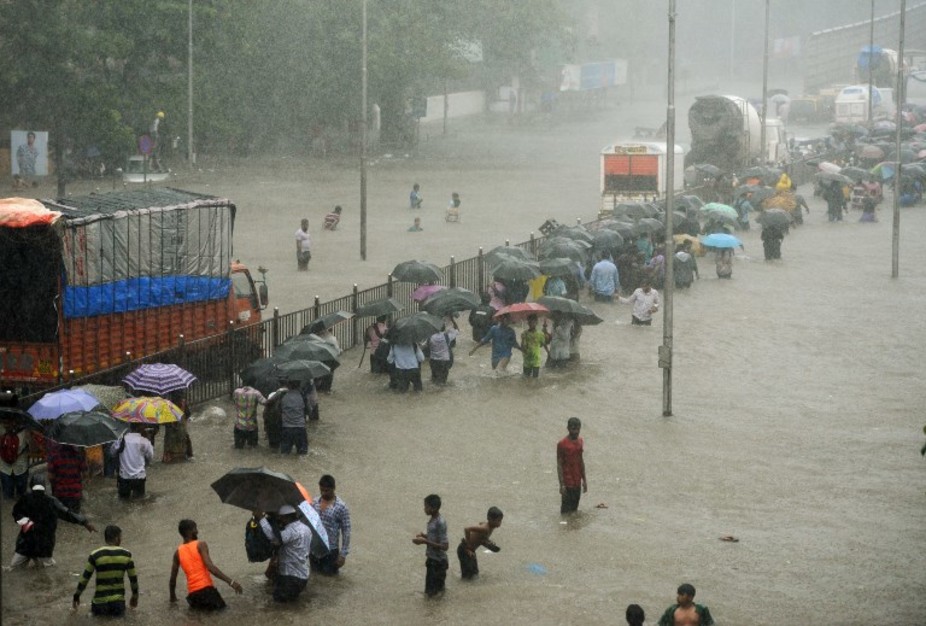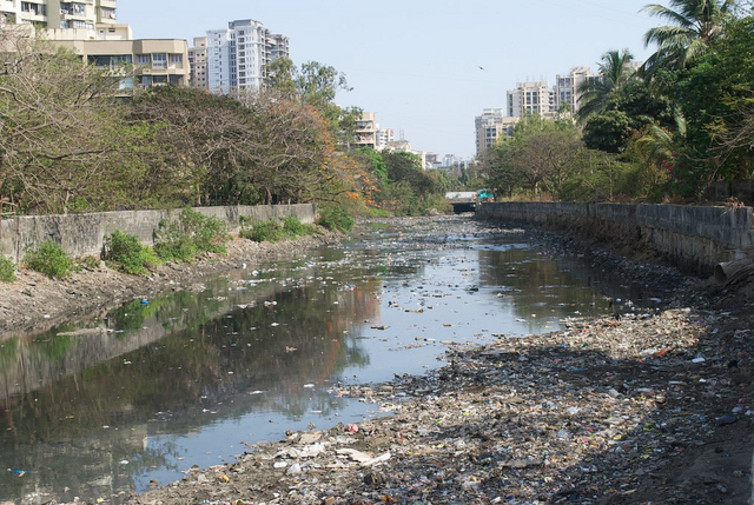Mumbai Floods: What Happens When Cities Sacrifice Ecology for Development
SPOTLIGHT, 4 Sep 2017
Harini Nagendra – The Conversation

Mumbai rains flooded the city for a week, leaving thousands helpless while building collapsed killing dozens on August 31th. PUNIT PARANJPE / AFP
1 Sep 2017 – As the storm that was hurricane Harvey deluged the areas around Houston, Texas, large parts of northern India, Nepal and Bangladesh also experienced heavy rains.
And the city of Mumbai was hit by another major flooding espisode. Several people have died in the city, many in the collapse of a four-storey building that is believed to have been weakened by the rains.
Overcrowded cities
Such loss of life in urban areas is often blamed on India’s overcrowding. Cities are growing at unprecedented rates. From a population of 2.86 million in 1950, Mumbai is now home to more than 21 million people, and is expected to have almost 28 million by 2030.
Built along the coastline on a series of islands, the city is surrounded by water: in mudflats, lakes, creeks, rivers, and the ever-present coastline.
Given the astronomical land prices in many parts of Mumbai, and the extreme scarcity of land, it is no surprise that Mumbai has sacrificed its ecology for development. Real estate projects, industry, and state infrastructure (railways, roads and the city’s airport) have built over, and choked, the city’s water networks at various strategic points. Every monsoon, the city floods.
Mudflats, wetlands, floodplains, mangroves and wooded vegetation once slowed down the flow of storm water. The mangrove’s complex root systems and the branching architecture of trees acted as a natural barrier to reduce the force of water flow. But now, they are built over. Garbage spread everywhere clogs the waterways. Most channels and waterways that connect water bodies have been built over too, resulting preventing streams from easily reaching the sea – forcing it to spread out into the low lying areas of the city, adding to the severe flooding.
Mumbai’s extensive wetlands and mudflats, which had connected parts of the city since the early 19th century, have disappeared. Their presence would retain the rain water and soak it into the ground, recharging the wells and ground water table.
Today, with nothing but concrete all around, the city’s land surface does not allow water to soak into it. In especially intense periods of rain, the devastation is extreme – at least 5000 people are believed to have perished in the infamous floods of 2005, and the economic damage was estimated at 30 billion rupees (US$690m).
The need for introspection
After the 2005 floods, a committee constituted by the government investigated the reasons for the devastation, concluding that there was an urgent need to restore Mumbai’s wetlands and water systems. In 2007, the municipality formulated the Greater Mumbai Action Plan, which among other efforts had a major focus on the restoration of the city’s main river, the Mithi, which had become little more than a sewage channel in parts.
Yet around the same time, the chair of the committee overseeing the plan, water expert Madhav Chitale spoke publicly about the lack of progress in implementing its recommendations. He said that the city lacked basic topographic data which were essential to build pathways for rainwater flow – which could have prevented flooding in subsequent rains.
In recent years, climate scientists, urban specialists and civic society groups warned repeatedly that Mumbai was heading for another heavy flood. A combination of the greater likelihood of high rainfall events because of climate change, and an even more inadequately prepared city, created a situation ripe for a disaster in the making. These warnings came true this monsoon season.
Mumbai’s planners know that climate change is leading to increased likelihood of extreme rainfall, and that restoration of the city’s wetland, river and floodplain networks is central to flood control. Yet the rush to develop construction projections in the city has often disregarded these factors. Money cannot replace nature in cities. A careful reading of Indian urban history shows that cities have historically grown with nature providing a support system. When this system is eroded – as is seen in so many Indian cities today, including in Delhi, Bangalore and Chennai – the very survival of the city is placed in question.
The story of Mumbai today is a reflection of the ills that plague many Indian cities – and those in other parts of the world as well, such as Miami and Houston. In a wetter future, it is clearer than ever that cities need ecology to grow.
___________________________________________
 Harini Nagendra – Professor of Sustainability, Azim Premji University
Harini Nagendra – Professor of Sustainability, Azim Premji University
Republish The Conversation articles for free, online or in print, under Creative Commons license.
Go to Original – theconversation.com
DISCLAIMER: The statements, views and opinions expressed in pieces republished here are solely those of the authors and do not necessarily represent those of TMS. In accordance with title 17 U.S.C. section 107, this material is distributed without profit to those who have expressed a prior interest in receiving the included information for research and educational purposes. TMS has no affiliation whatsoever with the originator of this article nor is TMS endorsed or sponsored by the originator. “GO TO ORIGINAL” links are provided as a convenience to our readers and allow for verification of authenticity. However, as originating pages are often updated by their originating host sites, the versions posted may not match the versions our readers view when clicking the “GO TO ORIGINAL” links. This site contains copyrighted material the use of which has not always been specifically authorized by the copyright owner. We are making such material available in our efforts to advance understanding of environmental, political, human rights, economic, democracy, scientific, and social justice issues, etc. We believe this constitutes a ‘fair use’ of any such copyrighted material as provided for in section 107 of the US Copyright Law. In accordance with Title 17 U.S.C. Section 107, the material on this site is distributed without profit to those who have expressed a prior interest in receiving the included information for research and educational purposes. For more information go to: http://www.law.cornell.edu/uscode/17/107.shtml. If you wish to use copyrighted material from this site for purposes of your own that go beyond ‘fair use’, you must obtain permission from the copyright owner.
